In the 1950s, men's overcoats represented a shift toward stylish practicality, reflecting post-war optimism. You'd notice knee-length designs replacing longer silhouettes. Heavy wool, herringbone, and luxurious cashmere blends dominated the fabric choices, ensuring both durability and elegance. Popular styles included trench coats and double-breasted raincoats, often adorned with faux fur collars for added warmth. Accessories like vintage gloves and polka dot scarves complemented these coats, enhancing their appeal. Influential figures like Cary Grant and Elvis Presley set trends that merged tradition with modern flair. If you explore further, you'll uncover more intriguing insights about this fashionable decade.
Historical Context of 1950s Fashion
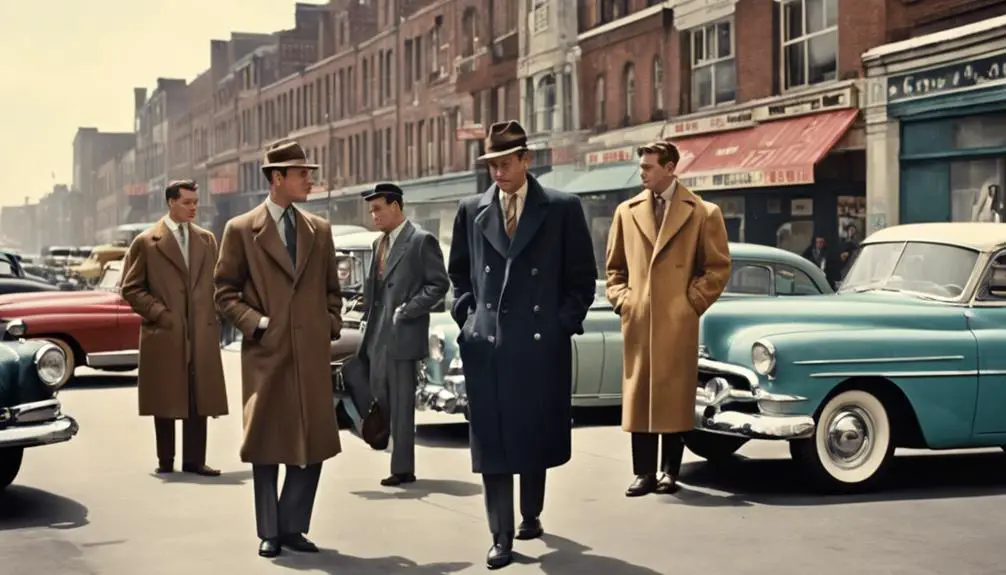
Shifting from the austere styles of the wartime years, the 1950s ushered in a fresh perspective on men's fashion, emphasizing practicality without sacrificing style. This decade marked a notable shift towards more functional knee-length overcoats, abandoning the elongated silhouettes of earlier years. You'd find that mens fashion embraced fabrics that combined durability and aesthetic appeal, with black wool becoming a staple choice for its versatility and classic look. Vintage clothing of this era often featured unique labels that help identify their authenticity, showcasing craftsmanship and design elements typical of the time, including those from brands like Fashionbilt.
During this era, overcoats showcased unique stylistic elements, such as exaggerated shoulder-to-waist ratios and raglan sleeve designs, enhancing both comfort and visual interest. The influence of post-war optimism is evident in the bold patterns and textures that adorned vintage overcoats, reflecting a society keen for self-expression and individuality. Iconic styles emerged, including the double-breasted raincoat and the crombie, providing fashionable options for colder weather while keeping practicality in mind.
In this vibrant context, mens fashion evolved to meet the needs of a populace ready to embrace change, blending comfort, style, and a sense of newfound freedom, setting the stage for future innovations in men's outerwear.
Key Features of 1950s Overcoats
As you explore the key features of 1950s overcoats, you'll notice that they were designed to create a distinctive silhouette that emphasized the male form through exaggerated shoulder-to-waist ratios. This design not only enhanced appearance but also conveyed a sense of stature and confidence.
Here are some defining characteristics of 1950s overcoats:
- Double Breasted Design: This style was popular, providing a structured look that added to the coat's sophistication.
- Ulster Variation: Featuring a 42-button front and Ulster collars, this style highlighted torso length and exuded a sense of elegance.
- Raglan Sleeves: These sleeves guaranteed a comfortable fit while also enhancing the coat's overall aesthetic, allowing for ease of movement.
- Quality Fabrics: Heavy, mottled wool and classic patterns like herringbone were common, guaranteeing durability and a stylish appearance.
The interplay of these features not only defined the overcoat's functionality but also complemented the fashion of the era, where trousers were often cut short to showcase contrasting socks. Together, all these elements created a polished and coordinated look that was characteristic of 1950s men's fashion.
Popular Overcoat Styles
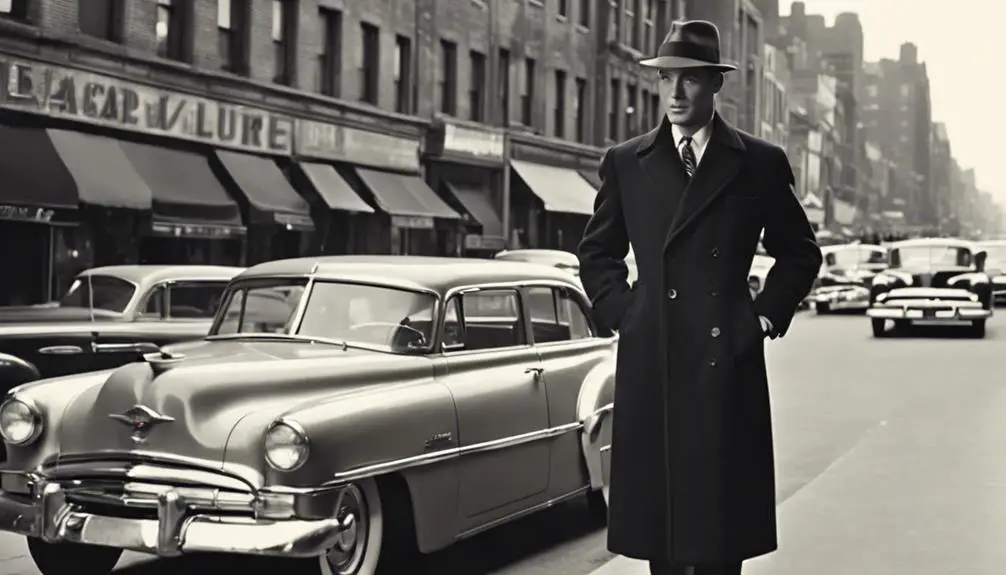
The allure of 1950s overcoats lies in their diverse styles, each reflecting the era's blend of functionality and fashion. You'll find that popular options like the trench coat, Crombie coat, and double-breasted raincoats became essential for men traversing both the streets and social events. The trench coat, with its iconic belted waist and water-resistant fabric, exemplified practicality while remaining a timeless fashion statement.
Overcoats in this decade often showcased exaggerated shoulder-to-waist ratios, with designs like the Ulster emphasizing torso length and distinctive collars, creating a striking silhouette. Knee-length coats gained traction for their versatility, offering warmth without sacrificing style. They frequently featured bold patterns and textures, capturing the essence of 1950s fashion.
Fabrics played a vital role in these styles, with heavy wool and Harris Tweed standing out for their durability and elegant appearance. The introduction of raglan sleeves allowed for greater mobility, enhancing comfort without compromising the coat's aesthetic appeal. Overall, these popular overcoat styles not only defined the decade but also set standards for men's outerwear that resonate even today.
Fabric Choices and Quality
During the 1950s, fabric choices for men's overcoats considerably influenced both their functionality and style, shaping how you perceive quality outerwear. The era emphasized durability and luxury, with materials like wool and cashmere blends taking center stage. The distinct textures and weaves of these fabrics not only provided warmth but also exuded sophistication.
Notable fabric choices included:
- Wool Windowpane: This fabric offered a classic checked pattern, enhancing the coat's visual appeal while maintaining warmth.
- Harris Tweed: Known for its rich textures and unique patterns, Harris Tweed represented the pinnacle of quality, often showcasing meticulous craftsmanship.
- Faux Fur Collars: Adding an element of luxury, these collars complemented the coat's overall aesthetic without compromising warmth.
- Velvet Accents: Used sparingly, velvet provided a sumptuous touch, making coats more visually striking.
Brands like Reid & Taylor emerged as leaders in the market, recognized for their commitment to quality weaving and craftsmanship. Vintage 50s overcoats remain highly sought after, not just for their style but also for the rich, textured fabrics that defined an era of elegance and sophistication.
Accessories That Complement Overcoats
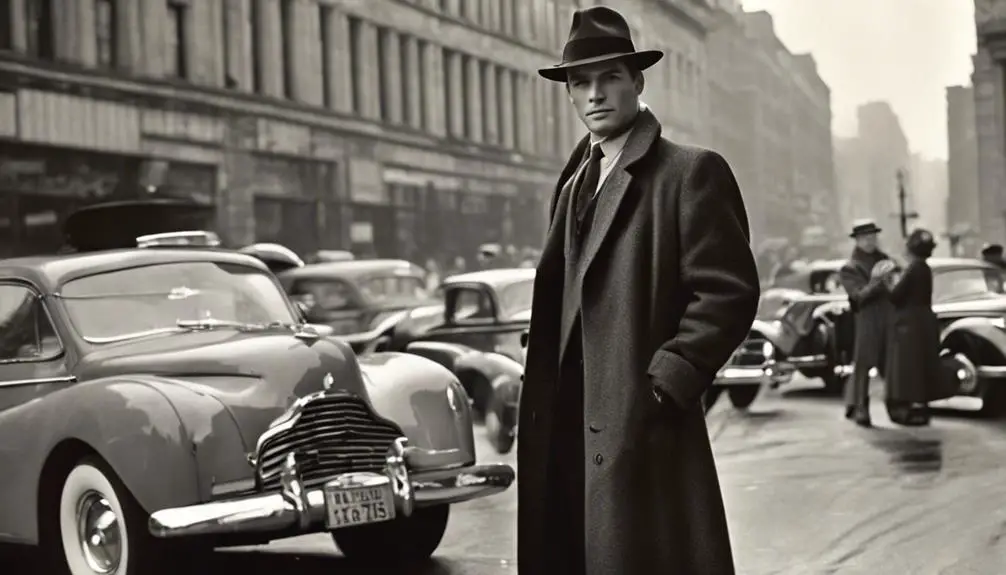
Quality fabrics set the stage for the overall aesthetic of men's overcoats in the 1950s, but accessories played a pivotal role in defining personal style and enhancing the ensemble. The right accessories not only complemented your vintage mens overcoat but also allowed you to express individuality.
| Accessory Type | Description |
|---|---|
| Gloves | Vintage gray leather gloves offered sophistication, while colorful options like yellow added flair. |
| Scarves | Polka dot scarves injected personality and warmth into the classic look. |
| Ties and Pocket Squares | Textured ties and pocket squares enhanced outfit coordination, elevating the formal appearance. |
| Hats | Fedora and trilby styles provided elegance and additional warmth during colder months. |
| Unique Accessories | Brooches and cufflinks allowed for personal expression, making your ensemble truly one-of-a-kind. |
Incorporating these accessories into your look could transform a simple overcoat into a statement piece. The 1950s were a time of experimentation in fashion, and by choosing the right mix of vintage mens accessories, you could create a sophisticated and stylish appearance that stood out in any crowd.
Influential Fashion Figures
Several influential fashion figures emerged in the 1950s, each leaving a distinct mark on men's overcoat styles. Their contributions shaped the era's aesthetic, blending sophistication with modernity.
- Cary Grant: Known for his impeccable tailoring, Grant's sophisticated overcoats epitomized the dapper gentleman, setting a standard for elegance.
- Christian Dior: While primarily recognized for his "New Look" in women's fashion, Dior's structured designs also influenced men's overcoats, emphasizing elegance and refined silhouettes.
- Dorian Leigh: As a leading model of the decade, Leigh showcased fashionable outerwear, boosting the visibility of stylish overcoats in men's fashion magazines.
- Elvis Presley: The King of Rock 'n' Roll introduced a casual yet stylish vibe to men's overcoats, often seen in black leather, melding traditional styles with a modern flair.
These figures not only defined the overcoat trends of the 1950s but also reflected the cultural shifts of the time, merging classic sophistication with the burgeoning influence of rock 'n' roll. Their styles continue to resonate, reminding us of the era's dynamic fashion landscape.
Trends in Men's Suits

The influence of fashion figures in the 1950s extended beyond overcoats to the domain of men's suits, where distinct trends emerged that reflected the decade's evolving style. Suits in this era showcased a lower gorge and shorter lapels, a departure from the longer proportions of previous decades. While the 41 silhouette from the 30s and 40s remained relevant, you might've noticed that the long torso designs sometimes created an awkward appearance.
Buttoning points became a focal discussion, as variations notably impacted the overall silhouette and aesthetic of the suit. Many men gravitated toward textured fabrics, particularly dark brown tweed, which added a layer of casual elegance to their look. However, it's crucial to recognize that the fullness and bagginess of 50s cuts often detracted from the elegance expected in tailored garments. Consequently, many began favoring more restrained styles, balancing comfort with sophistication.
As you navigate the world of 1950s fashion, you'll see how these suit trends not only defined personal style but also mirrored the cultural shifts occurring during the decade.
Vintage Market for Overcoats
As interest in retro fashion surges, the vintage market for 1950s overcoats is experiencing a notable revival. Collectors are increasingly drawn to these unique pieces, which often fetch prices ranging from $77.61 to $250.00, depending on their quality and brand. The scarcity of authentic 1950s styles makes them highly coveted, especially on platforms like Etsy and various auction sites. Additionally, understanding the vintage tag identification process can enhance a collector's ability to assess the authenticity and value of these garments.
The allure of vintage overcoats lies not only in their historical significance but also in their craftsmanship. Many of these jackets are made from high-quality materials such as cashmere and Harris Tweed, known for their durability and classic appeal. This trend toward retro aesthetics reflects a broader nostalgia for mid-century styles in contemporary fashion.
Here are some key factors driving the vintage market for mens overcoats:
- Rarity: Authentic 1950s jackets are limited in availability.
- Quality: High-quality materials enhance desirability.
- Nostalgia: A growing appreciation for retro aesthetics influences demand.
- Flexible Pricing: Listings often include shipping costs ranging from $9.98 to $42.74, with options for negotiation.
These elements make the vintage market a fascinating space for enthusiasts.
Care and Maintenance Tips
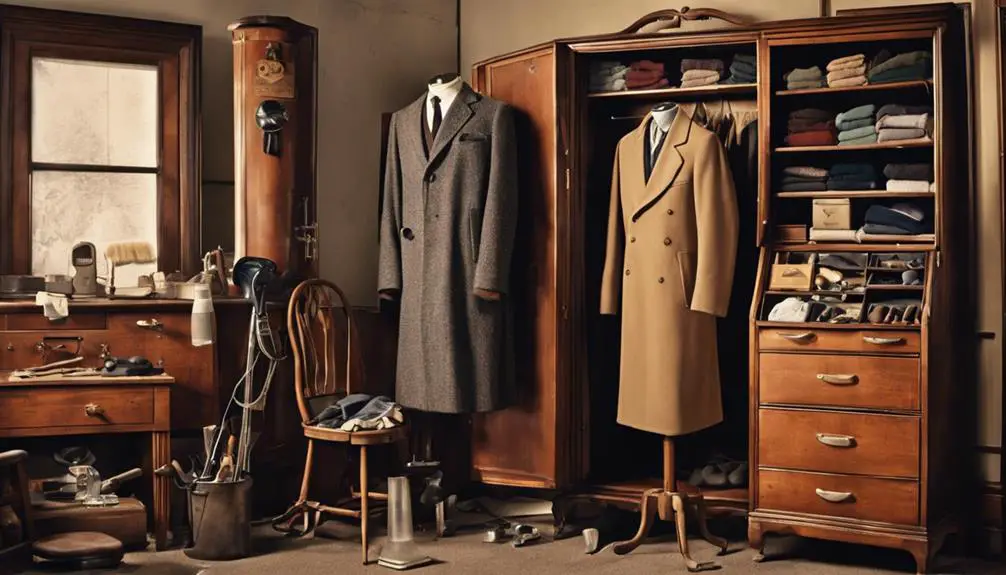
Owning a vintage 1950s overcoat is a rewarding experience, but it comes with the responsibility of proper care to guarantee its longevity and charm. To maintain the fabric quality and structure, always opt for dry cleaning instead of home washing. This helps prevent potential damage and preserves the coat's integrity.
Store your overcoat in a cool, dry place, away from direct sunlight to maintain its vibrancy and prevent fading. Regularly inspect your coat for any signs of wear and tear, as timely repairs can greatly prolong its lifespan.
Proper folding or hanging is essential to avoid creasing and to keep the coat's intended shape. Utilizing garment bags during storage can effectively shield your overcoat from dust and environmental factors.
Here's a quick reference table to help you remember these care tips:
| Care Tip | Recommended Action | Frequency |
|---|---|---|
| Dry Cleaning | Use professional services | Every season |
| Storage Location | Cool, dry, no sunlight | Year-round |
| Inspections | Check for wear and tear | Monthly |
| Folding/Hanging | Proper folding or hanging | After each use |
Adhering to these tips will make sure your overcoat remains a timeless piece in your wardrobe.
Frequently Asked Questions
When Did Men Stop Wearing Overcoats?
You'll notice that men gradually stopped wearing overcoats in the 1960s, as fashion trends shifted towards casual styles. The introduction of lighter materials and a focus on comfort further diminished the popularity of traditional outerwear.
Why Don't Men Wear Overcoats Anymore?
Men don't wear overcoats anymore because casual styles dominate, making functional outerwear more appealing. Lifestyle changes emphasize comfort over formality, and modern fabrics provide warmth without the bulk, shifting fashion priorities considerably.
What Type of Clothing Was Popular for Men in the 1950s?
In the 1950s, you'd see tailored suits, casual shirts, and stylish jackets dominating men's fashion. Accessories like ties and hats complemented outfits, reflecting a polished, sophisticated look that defined the era's sense of style and elegance.
When Did Overcoats Become Popular?
Overcoats became popular in the post-war era, particularly in the late 1940s and 1950s. You'll notice their appeal lies in tailored elegance, enhancing both warmth and style while reflecting the evolving fashion landscape of that time.
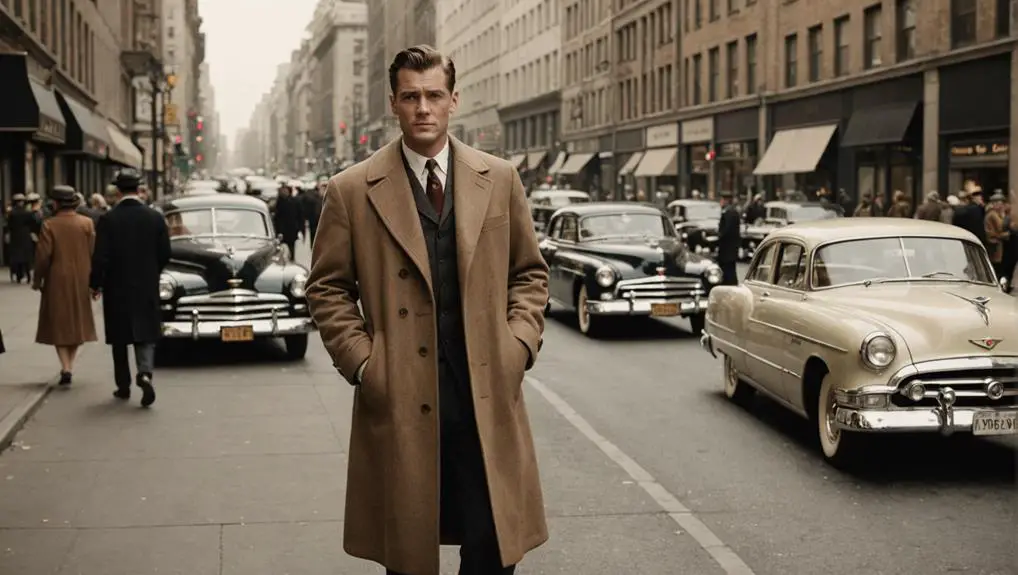




Aw, this was a really nice post. In thought I would like to put in writing like this additionally – taking time and actual effort to make a very good article… but what can I say… I procrastinate alot and under no circumstances seem to get something done.
In my opinion that a foreclosed can have a important effect on the applicant’s life. Property foreclosures can have a 6 to ten years negative effects on a applicant’s credit report. A new borrower who have applied for a home loan or virtually any loans for example, knows that a worse credit rating is, the more challenging it is for any decent personal loan. In addition, it could possibly affect any borrower’s capacity to find a good place to lease or rent, if that gets the alternative housing solution. Good blog post.